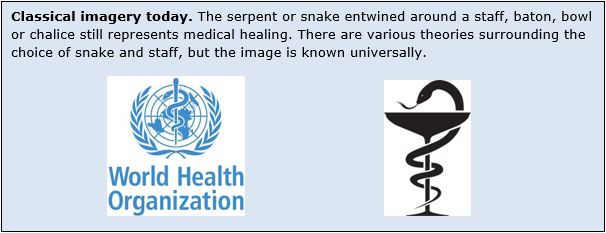The Pump Room roofline statues

The three statues which originally graced the roofline of the Pump Room were erected in 1827, as work on the building neared completion. They were the work of Lucius Gahagan Jr. (1798-1866), who worked principally in Bath and Cheltenham and was the third generation of a large family of sculptors. Each statue stands 7.5 ft (230 cm) tall and was sculpted in Bath stone. The statues were exhibited to the public in Gagahan's workshop in Bath, in May 1827, before they were brought to Cheltenham.
From left to right, the statues represent the classical figures Asclepius, Hygeia, and Hippocrates. They would have signalled to the patrons of the Pump Room that the building and its spa waters were dedicated to promoting health and well-being.
By 1900 the condition of the statues had deteriorated to the point where they needed to be supported, and so wooden and metal braces were added. Almost forty years later, even this was not enough, and the statues were deemed too fragile to remain in place. They were removed from the Pump Room in 1938, to much local consternation, and were stored by the council to await a promised future restoration.
Restoration was delayed by the Second World War, and did not begin until 1960. The old statues were no longer considered viable, and new interpretations (rather than exact replicas) were commissioned from stonemasons Richard Lockwood Boulton and Sons. The new statues were created by sculptor Patrick Conoley in 1965.
Asclepius
Asclepius (Latin Aesculapius) was often depicted with a serpent entwined round his club. He was the son of the Greek god Apollo and the princess Coronis, and was educated by the centaur Chiron, a strange yet wise creature, half-human, half-horse, famous for his skills in medicine. Asclepius was reputed to have performed many miraculous cures, and understood the importance of both physical and mental well-being. But he incurred the wrath of Zeus and Hades for upsetting the cycle of nature by bringing the dead back to life. In retribution, Zeus reluctantly struck him dead with a thunderbolt.
After his death, Asclepius became the focus of a cult who regarded him as a god, believing that he still had the power to cure them or release them from pain. The centre of the cult was at Epidaurus in southern Greece, where a temple, the Asclepeion, was built in his honour.

Hygeia
The female figure represented by the central statue is Hygeia, shown with a serpent and bowl of water. Hygeia was the daughter of Asclepius and his wife Epitone, the goddess of soothing pain. She was the chief assistant in her father’s healing work and represents preventative medicine and long life, giving her name to the philosophy of hygiene (in Ancient Greek ‘hygeia’ meant ‘soundness’ or ‘wholeness’, and hygiene in medicine concentrated on maintaining the ‘wholeness’ or health of the body). Statues of Hygeia were erected in all the major healing Asclepeion temples. The cult of Hygeia spread during the 5th century BC, with her primary temples at Epidaurus, Corinth, Kos and Pergamon.

Patrick Conoley’s figure of Hygeia is in a classical pose with the snake drinking from the bowl. This differs from the more animated original by Gahagan, in which her left arm was holding the bowl high above her head.
Hippocrates
On the right is the bearded figure of Hippocrates, again with serpent and staff. Hippocrates appears rather diminutive but his stance, hair and beard are a typical representation, along with a staff and snake. He was born around 460 BC on the island of Kos, and based his medical practice on observations of the human body. He believed that illness had a physical, rational explanation rather than being caused, for example, by the anger of the gods. Hippocrates was the first physician to describe accurately the symptoms of pneumonia and epilepsy and to believe that thoughts, ideas and feelings came from the brain, not the heart.
Hippocrates founded a medical school on Kos and began to teach his ideas. He developed an Oath of Medical Ethics for physicians to follow and is often called the father of medicine in western culture. The original form of the Hippocratic Oath required a new physician to swear by a number of healing gods - including Asclepius and Hygeia - to uphold specific ethical standards. The oath is the earliest expression of medical ethics in the Western world, establishing principles which continue to inform medical practice today. Swearing a modified form of the oath remains a rite of passage for medical graduates in many countries.
Judy Langhorn
A note on sources
With special thanks to Jill Waller of Cheltenham Local History Society for the following newspaper references:
Cheltenham Chronicle (16 June 1900): on the cleaning and restoration of the Pump Room and the three statues.
Gloucestershire Echo (4 January 1939): Cheltenham Borough Council’s justification of the removal of the statues, their condition (including the statement “… of the two figures sawn, one had been shored up by a wooden strut stated to represent a wooden club”), and the decision made to store the salvaged pieces.
Gloucestershire Echo (24 January 1939): a plea to an audience at Cheltenham Town Hall by Lord Gerald Wellesley FRIBA for the preservation of Cheltenham and in particular the pieces of the three statues removed from the Pittville Pump Room. He asks “who was the expert who said they should be sawn in pieces?”
And to Chris Conoley, son of Patrick Conoley, for sharing his recollections of his father’s work on the replacement statues (private communication, September 2018).